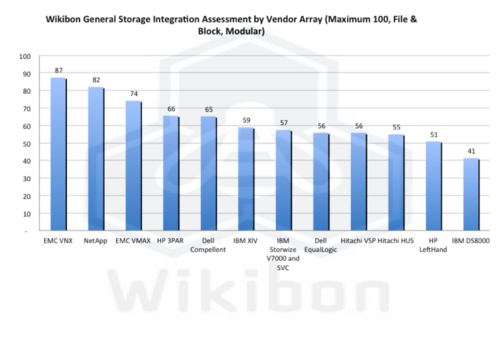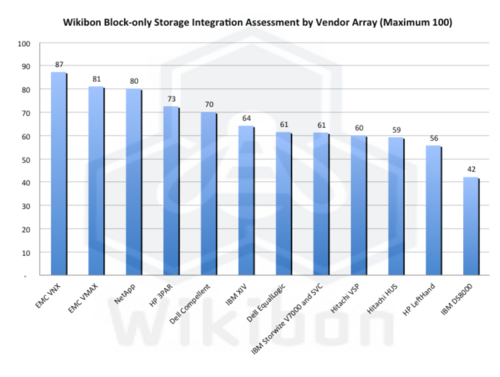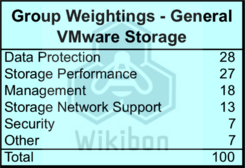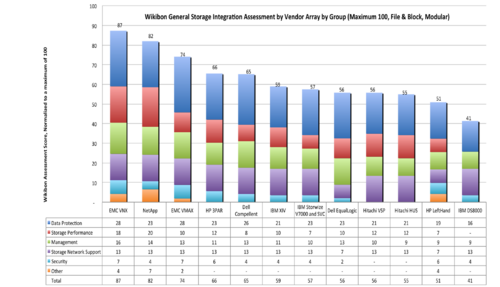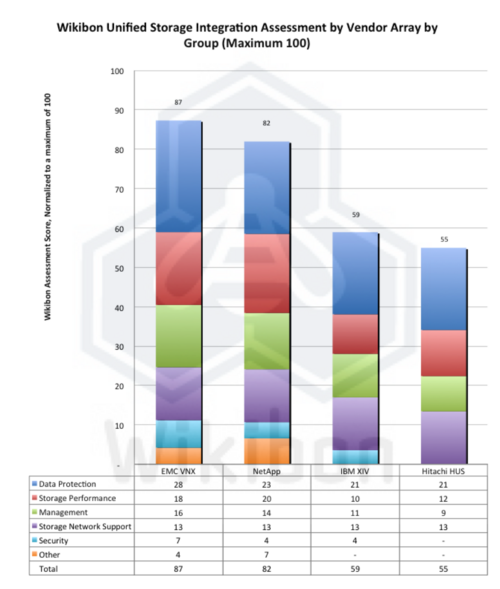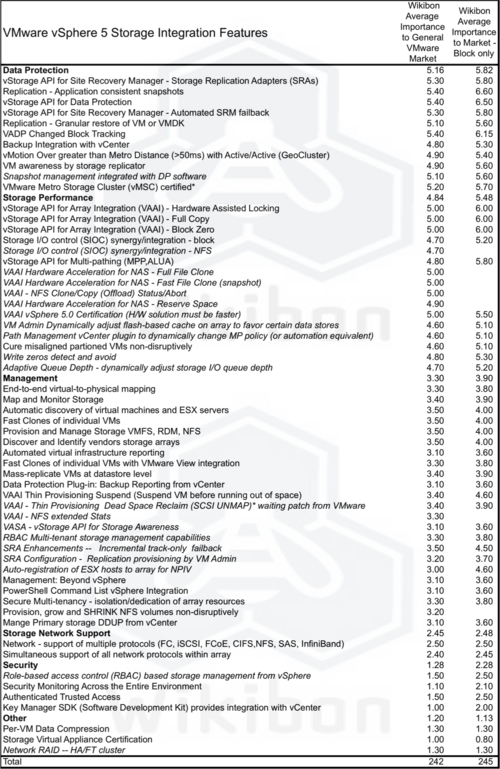Research done in collaboration with Stuart Miniman, Nick Allen and Ralph Finos
Contents |
Introduction
The elephant in the room for virtualization and storage is the tension between the traditional storage vendors and VMware. The storage array vendors prefer that storage management look and feel the same way regardless of environment. The VMware administrators want to manage storage using VMware tools and terminology.
Many of the integration points in vSphere 5 are designed to reduce this tension. The result? It is still a journey, and VMware users should not expect the final level of integration they need. However, vSphere 5 brings significant improvements in integrating the two views of the world, as evidenced in our recent survey of users, where we found a high level of satisfaction with vSphere 5 storage-related features. Some of the hybrid NFS implementations show promise that a total level of integration at the application level can and will be achieved.
In June 2011, Wikibon publish a report entitled EMC and NetApp lead in VMware Storage Integration Functionality, which covered the storage integration functionality in VMware 4. In July 2012, VMware announced new storage features in vSphere 5, including a significant number of changes in how storage is integrated as well as additional features in View, VMware’s VDI technology. Some of the most important features are under the covers. VMware had previously integrated many storage integration features from a few vendors into the VMware kernel. This was unsustainable in the long run, both from the point of view of the number of vendors supported and (more importantly) from the exposure from foreign code to VMware stability. VMware defined a large number of storage integration APIs, which not only covered the traditional block storage, but file-based (NFS) storage as well.
In September 2012, Wikibon reviewed additional input from vendors, and the charts were updated October 1 2012. There was some changes in positioning, but the main conclusions of the study remain.
Executive Summary
Integration is one factor in selecting storage and certainly not the whole story, but it is highly important for users. The purpose of this Wikibon research is to establish the level of integration against all the new VMware storage APIs for different vendors for two VMware environments: General Modular & Block-only (defined in detail in the following section). The two charts in Figure 1 & 2 below summarize the overall findings of our research.
The EMC VNX storage array leads in both categories. In the general category, the unified storage arrays such as the EMC VNX and NetApp FAS series do well, as they have integration features applicable to both block and file. The EMC VMAX is the first of the block-only vendors, with HP 3PAR and Dell Compellent in a statistical dead-heat for fourth place. Hitachi introduced the HUS Unified array to replace the AMS array, and the charts have been updated to reflect the changes. Hitachi vSphere Integration is still a work in progress. Despite the availability of the vSphere APIs to simplify the development process, IBM does not seem to have invested in implementing the new APIs. Perhaps they are saving that investment for new storage hardware.
In the block storage category, the EMC VNX is the clear leader, with the EMC VMAX in second place and a statistic dead-heat with the NetApp FAS array in third position. HP 3PAR is in fourth position. The same comments about IBM and Hitachi are also true for this category.
In general, higher levels of integration should equate to lower costs of management. Of course, many other factors need to be taken into account, including what is currently installed, levels of performance required, and the availability of functionality such as replication and tiered storage.
Arrays Analyzed
Wikibon Analysis of 12 different traditional arrays included:
- Dell Compellent & EqualLogic
- EMC VMAX & VNX
- Hitachi HUS & VSP
- IBM DS 8000, StorWize V7000 & XIV
- HP 3PAR & LeftHand
- NetApp FAS Series
We also looked at two hybrid arrays (non-oversubscribed) from Nimble and Tintrí. We did not do a detailed analysis of these hybrids, but Wikibon believes the best implementation of application-based VMware storage is to be found in the Tintrí NFS implementation. This is probably a harbinger of what the final integration will look like. Even though no Nimble or Tintri customers were in the survey, 10% of respondents voted them as the best VMware platforms.
Methodology
For our current study, we defined two groups of storage (compared with three in the 2011 study). They were:
- General VMware Modular Storage, including block & file-based storage. This is roughly equivalent to the Tier 2 definition in the 2011 study with the addition of file-based services. Our surveys and in-depth interviews indicated that this was the “sweet spot” of VMware storage.
- Block-only VMware Storage. This base was set at a higher functionality, performance and reliability standard than the modular storage, but was block only.
Wikibon also looked at an NFS-only category, but we have left detailed analysis of this category for another occasion.
Wikibon created an initial list of integration features and put them into six groups. We then asked each vendor whether the feature was available or not and whether the vendor had implemented any specific features not covered by the list. We ended up with 57 integration points for the General VMware Modular storage case (nearly twice the 2011 study), and 50 integration points for the block-only VMware storage case.
See VSphere V5 Storage Integration Points for explanations of the full feature list examined in this study.
The groups and the factors within them were then assessed and weighted for importance. The two tables below show the weightings for the six groups for general and block-only storage. Table 5 shows the full table in the footnotes.
Detailed Results
Figures 3 & 4 show the detailed results for general modular and for block-only storage by vendor and group. Figure 5 shows the results for unified storage offerings. The charts show that we gave greater weight to data protection, performance, and management.
Conclusions
The overall conclusion is that the leading vendors have implemented strong integration features with VMware. However, this is far from the end of the journey. The journey-end can be glimpsed by looking at the Tintrí operating panel, where all the information about the storage used by an application is available to the operator in great detail, and where LUNs don’t exist. Wikibon estimates we are about half way on the journey to full integration of VMware storage at the application level with full management and analysis detail. In the meanwhile, EMC and NetApp continue to lead in VMware storage integration in vSphere 5.
Action Item: Users should use these findings to help understand what integration features are available, and which vendors have installed them. They should then use their own weightings in assessing the potential benefit of these features in their environment, in conjunction with the other factors already on their evaluation list. Wikibon would be happy to assist individual organizations that would like to run the numbers against their own evaluation weightings.
Footnotes: Also see Wikibon 2012 vSphere 5 Survey shows Customer Satisfaction and Rapid Adoption
Wikibon's 2011 VMware Storage Integration Journey Checkpoint of vSphere 4.x (research and survey summary)
Wikibon's 2010 The Value of the VMware Integration Journey
Full list of Wikibon's VMware related research here.
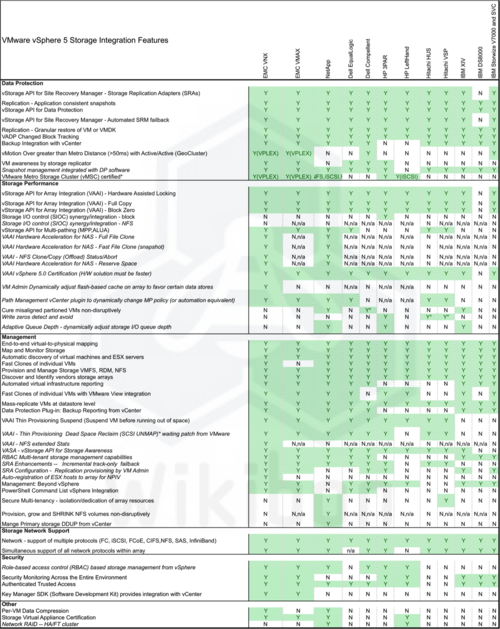
Source: Wikibon October 2012. Detailed information about the definition of the vSphere 5 Integration Features is given at [1], updated October 2012



